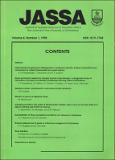| dc.contributor.author | Chawatama, S. | |
| dc.contributor.author | Ndlovu, L.R. | |
| dc.contributor.author | Dzama, K. | |
| dc.contributor.author | Tsimba, R. | |
| dc.contributor.author | Topps, J.H. | |
| dc.contributor.author | Mutimba, J. | |
| dc.coverage.spatial | Zimbabwe. | en |
| dc.date.accessioned | 2016-02-19T12:47:10Z | |
| dc.date.available | 2016-02-19T12:47:10Z | |
| dc.date.issued | 1998 | |
| dc.identifier.citation | Chawatama, S. et al., (1998) Socio-economic aspects in draught animal-crop linkages: a diagnostic study of Tsholotsho, Chinyika and Mutoko smallholder farming areas of Zimbabwe, Journal of Applied Science in Southern Africa, vol. 4, no.1, pp. 11-19. Harare: UZ Publications. | en |
| dc.identifier.issn | 1019-7788 | |
| dc.identifier.uri | https://opendocs.ids.ac.uk/opendocs/handle/20.500.12413/9022 | |
| dc.description | A research paper on Zimbabwe's small-holder farmers' constraints in crop production due to shortages of draught animal power during the 1994/95 agricultural season. | en |
| dc.description.abstract | A survey was conducted on 451 households in Tsholotsho, Chinyika and Mutoko smallholder areas to understand farmers’ crop production constraints in relation to draught animal power (DAP) during the 1994/95 agricultural season. Farmers without DAP constituted 48.6 percent in the three districts. Of these, 54.5 percent had access to neighbours’ or relatives’ animals. The rest hired or worked in others’ fields in exchange for draught animals. Animal diseases and shortage of grazing land were noted as the major constraints in animal production. Both farmer education and experience as well as household head were found to be associated with district (p<0.001). Tsholotsho had the largest number of farmers (52.8 percent) with more than 10 years experience while Mutoko had the largest proportion (43.3 percent) of Master farmers. Farmer education and experience were found to be independent of sex. The average land holdings per farmer for Tsholotsho, Chinyika and Mutoko were 6.21 ha, 4.22 ha and 1.62 ha, respectively. Tsholotsho is a dryland communal area whilst Chinyika is a relatively wet area. Mutoko is a typical communal area with a high population pressure. Maize is the main crop in Chinyika and Mutoko whilst millet is the most common in Tsholotsho. | en |
| dc.language.iso | en | en |
| dc.publisher | University of Zimbabwe (UZ) Publications | en |
| dc.rights.uri | http://creativecommons.org/licenses/by-nc-nd/3.0/ | en |
| dc.subject | Agriculture | en |
| dc.subject | Economic Development | en |
| dc.subject | Rural Development | en |
| dc.title | Socio-economic aspects in draught animal-crop linkages: a diagnostic study of Tsholotsho, Chinyika and Mutoko smallholder farming areas of Zimbabwe | en |
| dc.type | Article | en |
| dc.rights.holder | University of Zimbabwe (UZ) | en |


